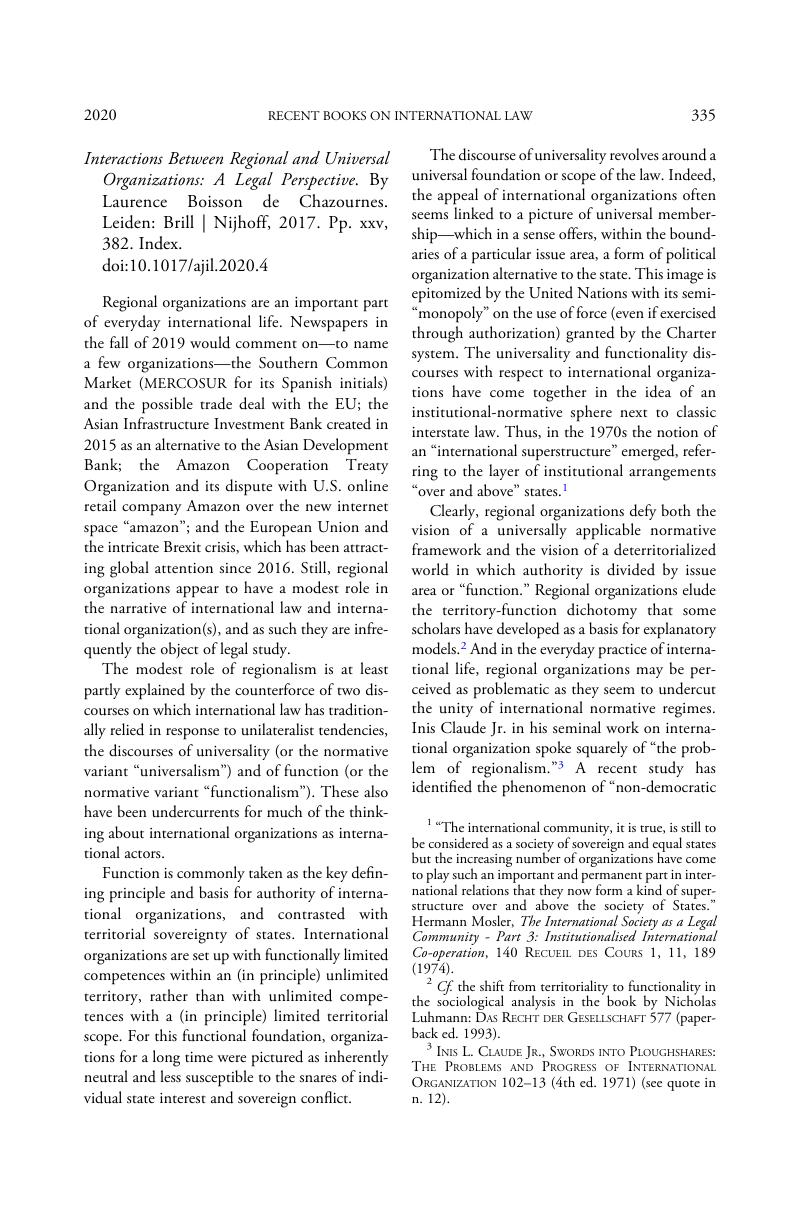No CrossRef data available.
Published online by Cambridge University Press: 16 April 2020

1 “The international community, it is true, is still to be considered as a society of sovereign and equal states but the increasing number of organizations have come to play such an important and permanent part in international relations that they now form a kind of superstructure over and above the society of States.” Mosler, Hermann, The International Society as a Legal Community - Part 3: Institutionalised International Co-operation, 140 Recueil des Cours 1, 11, 189 (1974)Google Scholar.
2 Cf. the shift from territoriality to functionality in the sociological analysis in the book by Nicholas Luhmann: Das Recht der Gesellschaft 577 (paperback ed. 1993).
3 Inis L. Claude Jr., Swords into Ploughshares: The Problems and Progress of International Organization 102–13 (4th ed. 1971)Google Scholar (see quote in n. 12).
4 Anastassia V. Obydenkova & Alexander Libman, Authoritarian Regionalism in the World of International Organizations: Global Perspective and the Eurasian Enigma (2019).
5 A recent exception is the Symposium on “Regional Organization and Regional Integration” in the European Journal of International Law (see, e.g., the introduction by Chalmers, Damian, Regional Organizations and the Reintegrating of International Law, 30 Eur. J. Int'l L. 163 (2019)CrossRefGoogle Scholar.
6 See, e.g., Henry G. Schermers & Niels M. Blokker, International Institutional Law, at paras. 1691–741 (6th rev. ed. 2018); Jan Klabbers, An Introduction to International Organizations Law (2015) (chapter 13 on “inter-IO liaisons”); see also early concerns in Clarence Wilfred Jenks, Co-ordination: A New Problem of International Organization: A Preliminary Survey of the Law and Practice of Inter-organizational Relationships, 77 Recueil des Cours 151 (1950); Dupuy, René-Jean, Le droit des relations entre les organisations internationales, 100 Recueil des Cours 457 (1960)Google Scholar. Note that none of these authors single out regional organizations.
7 See, e.g., Michel Virally, Les relations entre organisations régionales et organisations universelles, in SFDI, Régionalisme et universalisme dans le droit international contemporain 147–65 (1977).
8 de Chazournes, Laurence Boisson, Les relations entre organisations régionales et organisations universelles, 347 Recueil des Cours 79 (2010)Google Scholar.
9 Chapter VIII, entitled “Regional Arrangements,” comprises Article 52 (regional arrangements engaging in pacific settlement of a dispute); Article 53 (regional arrangements taking enforcement action, only upon authorization of the UN Security Council); and Article 54 (duty to keep UN Security Council informed).
10 Chapter VII “Action With Respect to Threats to the Peace, Breaches of the Peace, and Acts of Aggression,” specifically includes the Charter provisions on the lawful use of force and enforcement measures.
11 Article 48(2) reads: “Such [Security Council] decisions shall be carried out by the Members of the United Nations directly and through their action in the appropriate international agencies of which they are members” (emphasis added).
12 Behrami and Behrami v. France (Application No. 71412/01); and Saramati v. France, Germany and Norway (Application No. 78166/01), Admissibility Decision (Eur. Ct. Hum. Rts. May 2, 2007) (on attribution of impugned conduct to, respectively, the NATO Mission in Kosovo and the UN Mission in Kosovo rather than to the member states whose nationals were involved).
13 Ahmed Ali Yusuf and Al Barakaat International Foundation v. Council of the EU and Commission of the EC, Case T-306/01, and Yassin Abdullah Kadi v. Council of the EU and the Commission of the EC, Case T-315/01, Judgments (Ct. First Instance Sept. 21, 2005). Plaintiffs saw assets frozen pursuant to a UN Security Council Resolution and a subsequent EU Regulation; they claimed this was unlawful and amounted to a breach of human rights. The Court of First Instance held it was not able to review UN Security Council Resolutions.
14 Joined Cases C-402/05 P and C-415/05 P, Yassin Abdullah Kadi and Al Barakaat International Foundation v. Council of the EU and Commission of the EC, Judgment (Eur. Ct. Just. Sept. 3, 2008) (the Court in this decision conceptualized the EU as an autonomous order and annulled the impugned Regulation, due to breach of, inter alia, the right to property).
15 Bosphorus Hava Yolları Turizm ve Ticaret Anonim Şirketi v. Ireland, Application No. 45036/98, Judgment (Eur. Ct. Hum. Rts. June 30, 2005) (member states of an international organization (such as the EU) can take measures based on obligations following from their membership “as long as the relevant organisation is considered to protect fundamental rights in . . . a manner which can be considered at least equivalent to that for which the Convention provides” (para. 155)).
16 The Articles on the Responsibility of States for Internationally Wrongful Acts, which are widely used as a reflection of customary law, were adopted by the UN International Law Commission at its fifty-third session, in 2001, and submitted to the General Assembly in that same year (see Yearbook of the International Law Commission, 2001, Vol. II (Part Two)).
17 UN Secretary General, Cooperation Between the United Nations and Regional and Other Organizations, para. 145, UN Doc. A/71/160, S/2016/621 (2016).